KEF LS60 Wireless Powered Loudspeakers Review
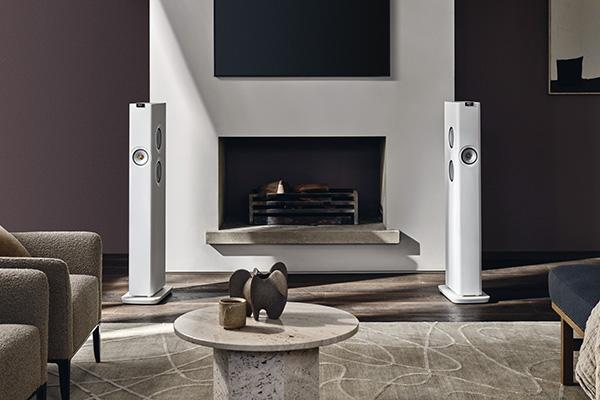
AT A GLANCE
Plus
Reference-grade sound quality, dynamics
Virtually full-range extension
Simple-as-possible app for setup, control
Subwoofer output
Minus
No easy path to multichannel integration
No music-data or volume display
No phono input
THE VERDICT
The ultimate streaming standalone system.
KEF's LS60 is not just a speaker; it's an acoustic revolution packed into a sleek tower of sound. From its state-of-the-art technology to its jaw-dropping design, prepare to meet the future of high-end audio. If you’ve been looking for a “just-add music” stereo system under seven or eight grand (or, for that matter nine or ten), you can stop.
Whatever the opposite of “burying the lede” is, I think I just did it. Don’t care: KEF’s new LS60 wireless, powered tower streaming loudspeaker system is just that good. I’ve been evangelizing active-speaker design as the only sensible way to engineer a music system for more decades than I’m prepared to admit in print, and in the digital age my preference has been borne out with a dramatic flowering of truly excellent, smart, streaming powered speakers. And the LS60 is, by a pretty wide margin, my new favorite of the bunch.
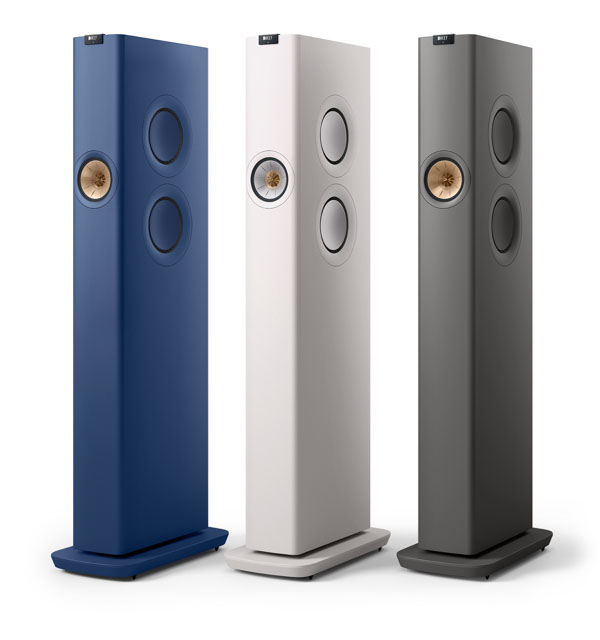
First, what is it? Visually, the KEF LS60 is a super-slim tower with a 2-way concentric driver visible on its narrow baffle, and a quartet of dual-opposed woofers on the sides. It’s a strikingly dramatic look once you get past the slightly Cyclopian face; the association with Kubrick’s Space Odyssey is irresistible, but as far as I know no hominids were harmed in its design or manufacture. There is no grille, though, so those with undisciplined cats, ferrets, or small children be forewarned.
Functionally, the LS60 is to a fair extent a tower-ized mashup of KEF’s LS50 Wireless II bookshelf active-streamers, and a pair of the firm’s KC62 nano-compact subwoofer, both of which I’ve reviewed favorably in these pages over the past couple of years. (KEF may object to this characterization, but the analogy is tough to avoid.)
I will leave most of the technical details to the reader’s searching, either here or on KEF’s own site, but briefly: The centerpiece is KEF’s long-running Uni-Q coincident mid-range/tweeter driver array, which is what you see on the front of the LS60.
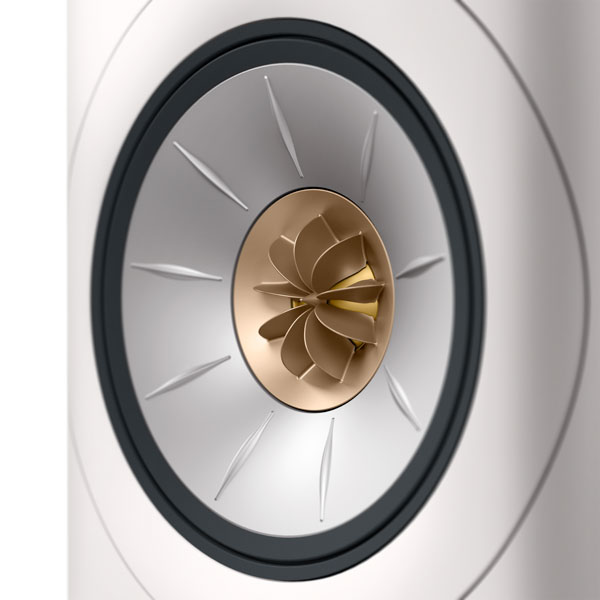
Like the LS50 Wireless II the LS60’s Uni-Q is refined by KEF’s “metamaterial” back-chamber, which absorbs the tweeter section’s unwanted back-wave via a labyrinthine assembly of teeny Helmholtz resonators, with the result being, it is said, cleaner, more defined output. And like the KC62 sub’s, the LS60’s double-paired bass drivers employ a clever arrangement of overlapping, back-to-back voice coils, sharing a common former, that enhances efficiency, reduces distortion, and enables highly compact packaging in a “force-canceling” layout—back-to-back in-phase, whereby mechanical nonlinearities tend to cancel out—in an enclosure just over five inches wide.
Onboard each speaker are three power amps: 500 watts to the woofers, and two 100 watts jobs for the Uni-Q mid and tweet. Interestingly, the low and mid units are Class D while the tweeter amp is AB. (I don’t read anything into this other than packaging/efficiency needs, but you’d have to ask KEF why.) Also on board is DSP for crossovers, equalization, and (presumably) dynamics/distortion management, and the same streaming smarts and WiFi and Bluetooth wireless tech that make the LS50 Wireless II tick. These respond to the proprietary KEF Connect app (iOS/Android), which delivers Amazon, Deezer, Qobuz, Spotify, and Tidal services inbuilt, AirPlay 2 and Chromecast “casting” access, and Roon Ready “endpoint” functionality.
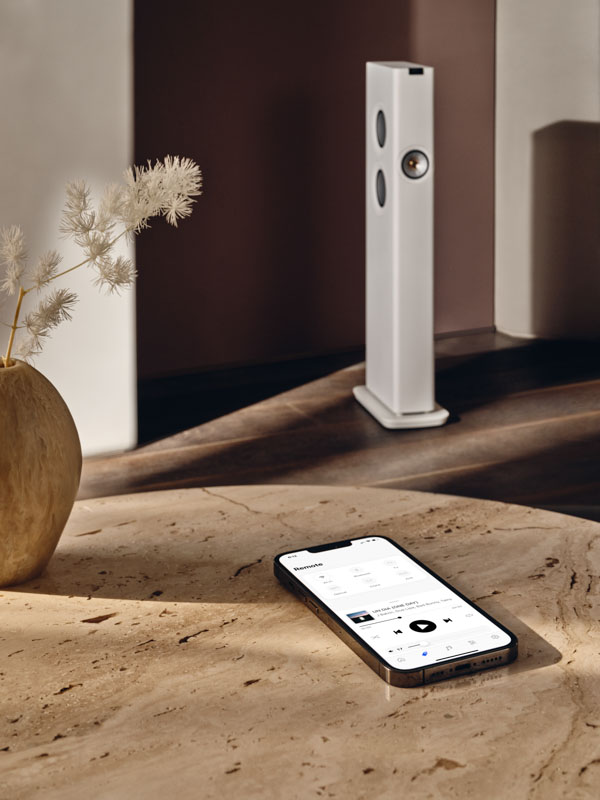
From the front the two speakers are identical; from the back they differ substantially. The “primary” unit, which can be assigned left or right at setup by the KEF Connect app, has coax, optical, and HDMI/eARC wired digital audio inputs, a single stereo-minijack analog input, a for-service-only USB port, and not one but two RJ45 Ethernet ports. The one marked “Network” connects your local network if you lack WiFi or prefer not to use it for the system. The second, marked “Interspeaker,” can physically interconnect the two LS60s using a supplied, heavy Ethernet cable. When fully wireless, the system is limited to a max of 24-bit/96 kHz resolution, but when the pair is hard-wired by this second Ethernet cable, this bumps up to 24-bit/196 kHz. (Yes, I tried it both ways, and no, I perceived no difference whatsoever. If you can—and can prove it—you’re a better man than I am, Gunga Din.)
Both speakers of course have IEC sockets for their power cords—remember, wireless does not mean cordless—and neither sports any physical, hardware controls whatsoever. A small remote controller furnishing the basics is supplied, but an iOS or Android device running the KEF Connect app is absolutely required for setup and, honestly, for any occasional adjustments one might want to make down the road.
Setup & Listening
I don’t know if there is an awards show for packaging design (The Boxies?), but if there is, KEF’s for the LS60 is a surefire statuette-winner. The very clever design, employing mostly cardboard and similar “green” materials, allows you to un-clip a top section, slide off a middle section, and then fold down the lower section so you can then “walk” the speaker out of the packaging without actually lifting anything heavier than the accessories box: brilliant!
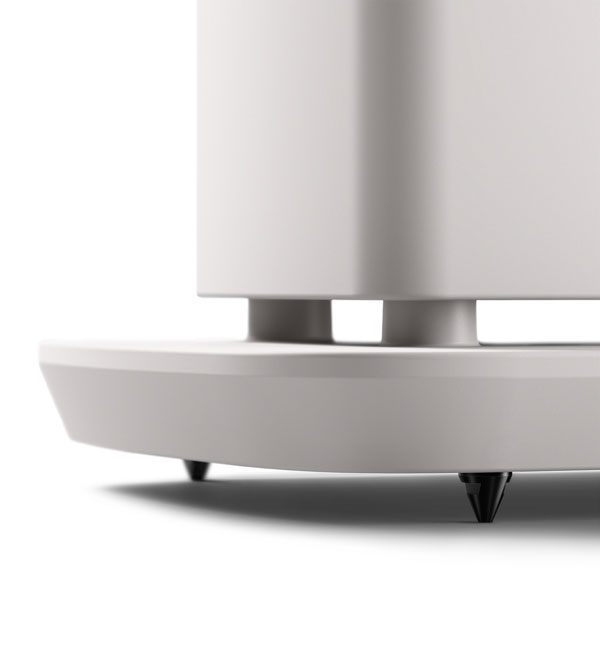
The LS60 design incorporates a heavy alloy base that keeps the very narrow tower quite stable (optional spikes are included). It’s in place out of the box, so for once I didn’t have to balance an upside-down tower while fiddling with hardware. After walking them into place, setup consisted only of plugging in the two supplied power cords, and running KEF Connect on my iPhone XS, which “found” and activated the speakers pretty much automatically. I switched over to the wired-Ethernet/hardwire interconnect setup a few days later and used this for all my critical listening, mostly via Roon with the KEFs as an endpoint for full resolution. I logged into my Qobuz account through the KEF Connect app’s Music page gateway, and was streaming hi-rez audio within just a few minutes.
And what audio! KEF’s LS60s sound like nothing at all, which is precisely what a truly transparent audio system should do.
I started with a tour of some of the very familiar tracks I keep in my “Testing” Roon playlist. “Cry Me a River,” from Bonnie Bramlett’s 2007 Still the Same album, is a textbook studio production, highlighting extremely clean and present recording and, of course, Bramlett’s (now Sheriden) rich, husky contralto—really, almost a tenor. The KEFs made this hair-raisingly alive, filling all the space between the speakers, with the vocal thrust roundly out into the room. This track has a lot of energy in the pop-bass octaves—say, 40-160 Hz—and the LS60’s reproduced it faultlessly: rich and gooey, but never bloomy or boomy.
In fact, on track after track the KEFs matched my long-term stand-mount 3-ways almost perfectly, which I consider high praise. The only tell-tales were the LS’s barely warmer/fuller vocal range—a comparison probably showed the long-terms’ slight midrange/tweeter suckout, a danger to all conventional multiway speakers but one that KEFs Uni-Q coaxial topology largely solves—and the KEFs’ clear edge on bass extension, evenness, and dynamics.
The LS60s could play this track, and every other I auditioned, as loudly as ever I’d ask, and indeed a good bit louder (perhaps 6 dB more) without any change in tonality, clarity, or dimensionality—very impressive.
Speaking of dimensionality: The LS60s produce a broad, tremendously stable and pinpoint soundstage, but a fairly “flat” one; my conventional-box 3-ways sounded slightly but audibly deeper or “spacier” on recordings with a lot of ambient (treble) content. This is not too surprising, as the Uni-Q layout is a controlled-directivity design (essentially, a horn mid/tweet) that sprays a bit less upper-frequency energy toward the side and back walls than do my double-dome everydays. This is one key to the LS60’s superb tonal accuracy: off-axis sound is inevitably less flat and smooth than the direct output, and that affects the overall perceived balance. (Indeed, a large part of what loudspeaker engineers sweat over is getting the off-axis balance as similar as possible to that on-axis.) I don’t mean to overstate this; it’s not a big difference. But if audiophile-style depth/air is your audio jam, the KEFs may not spread it thick enough for you.
But don’t misconstrue: On an aural feast like the Ives ``A Concord Symphony”—the piano sonata arranged for full orchestra by the late Henry Brant—the San Francisco Symphony’s recording under Michael Tilson Thomas (SFS Media) is gloriously big, and the KEFs spread the stage fully between the speakers, and even slightly beyond them, with electrifyingly lifelike instrumental definition and localization. The second movement 'Hawthorne' runs the gamut from quiet murmurations to full-bored Ivesian chaos, and the ‘60s glistened with every iota of Ives’ dynamics madness and Brant’s genius for colorful orchestration. I found myself thinking the detail-rich effect was like listening on a state-of-the-art headphone setup—but one that images properly out in front rather than vaguely somewhere inside your head.
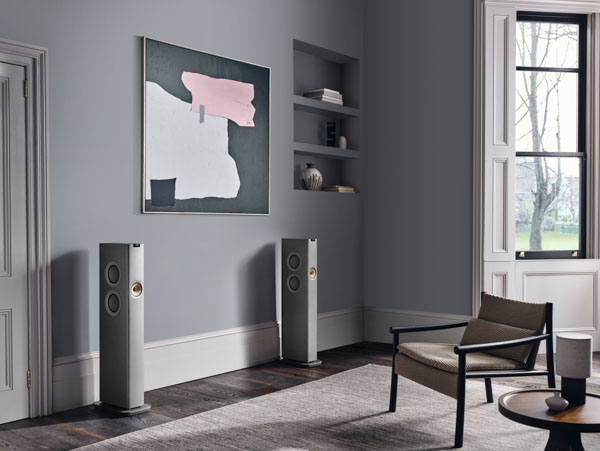
Low and deep and loud? I’ll say: I keep a handful of electronica/dubstep tracks in my playlist, and the LS60s pumped out levels of sub-35 Hz bass that beggared belief. Which you gonna believe, your ears or your lyin’ eyes? They had no difficulty awakening rattles in my pretty thoroughly de-rattled room, a sure sign of 95 dBSPL-plus action at 30 Hz or thereabouts. And even at these extreme levels I detected no audible loss of deep-bass weight from dynamics/low-frequency limiting, which, given the LS60’s DSP-based smart-EQ design, I’m sure was happening to at least some degree. I guess KEF’s smart-limiting is just too smart for me.
Function Follows Form
As mentioned, the LS60s themselves have no physical controls controls or displays, other than a tiny pilot LED on each that glows or flashes different colors to denote various conditions, such as Standby, Power-On, Pairing, and so on (there is a small remote, which we’ll get to). This makes the KEF Connect app essential for setup, and useful for everyday listening.
I’ll skip over most of the setup process, which was perfectly straightforward and in any case is mostly identical to that of the LS50 Wireless II we’ve covered previously in this space. The app presents five swipe-able panes - home, remote, music, EQ, and setup. The first is a convenient amalgam of most-used sources/streams and controls; the second duplicates the supplied remote control, and the third selects from Amazon, Deezer, Qobuz, Spotify, and Tidal services, a pretty comprehensive list of Internet-radio streams, or a media-server accessing your own locally stored music files.
The EQ pane is the most interesting in our context here. “Wall mode” modifies the LS60s’ bottom three octaves or so by half-dB increments down to -10 dB, to compensate for their proximity to the front wall. (This is more or less a “bass” control, but one that doesn’t shelve all the way up into the few-hundred-Hertz range like most such knobs.) “Treble trim” does what is says, also by half-dBs, over a ±3 dB range: enough to compensate for room acoustics and furnishings reasonably, but limited enough that the user can’t possibly screw things up entirely. “Bass extension” in essence lets you choose your tradeoff of deepest bass reproduction versus maximum volume, from among Less, Standard, and Extra. I used the last option almost all the time and never felt cheated of level, but my volume preferences are (relatively) reserved. For demanding full orchestra stuff like the Ives referenced above I went to Standard, mostly on principle. I tried to plumb the subtleties of the Less/Standard choice on some dub and hip hop tracks, but at the levels at which the action began to be noticeable were so extreme I quickly abandoned the exercise as academic—in my room and my view, anyway.
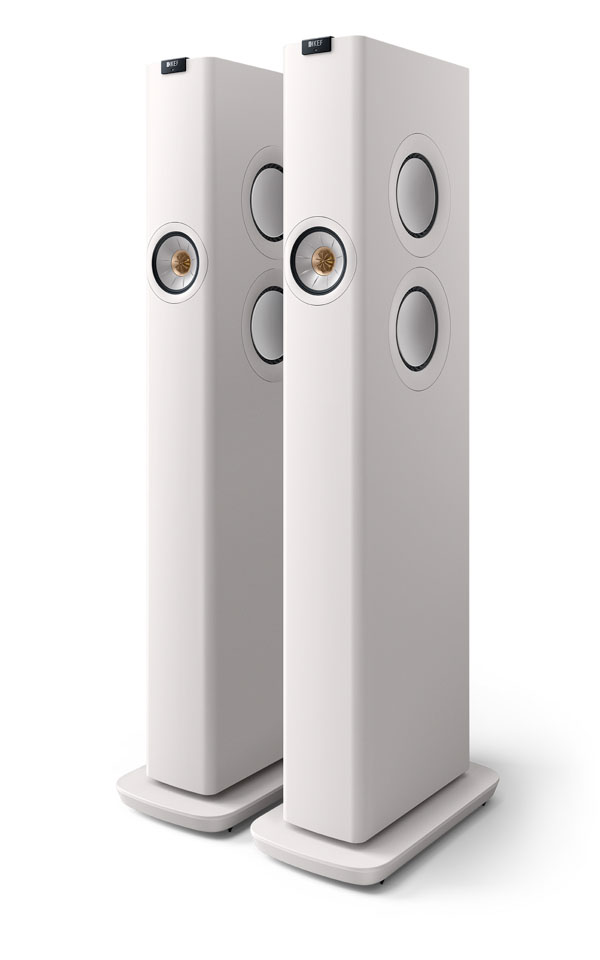
Elsewhere on the KEF Connect page are a left/right balance and settings for integrating a subwoofer, which seems a bit of lily-gilding since the KEFs proved unrestricted to at least 30 Hz, in my room anyway, and the mysterious Phase Correction.
This last feature compensates for the various latencies introduced by the LS60’s DSP and other circuits (and electro-mechanical ones in the actual drivers), to “time-align” the Uni-Q’s mid/tweet elements, and the '60s woofers, to supply a perfect “step-response” graph. The audibility of this sort of thing has been a topic of vigorous, cheerful (well, usually) debate among the audio-obsessed for about 50 years now, still without definitive conclusions. Did I hear a difference when flipping correction on and off? Occasionally, yes: more often, no. Could I characterize the change as “better/worse”? Absolutely not; I can’t even describe it as an audio effect per se: more of a microscopic perceptual shift, like the background pattern of one’s vision, except in your ears.
I briefly tried all the KEFs’ various inputs and streams, without any adventure. Bluetooth paired up quickly to my iPhone XS, and the eARC HDMI input talked to my Sony A8H OLED set sans complications. I didn’t notice any latency issues on the LS60s’ HDMI input, but I didn’t spend a great deal of time with it. Unless you have a very large room or a serious volume’n’bass habit, adding a subwoofer to the ‘60s seems to me unnecessary, but I tried it, again, briefly: it works. (The secondary LS60 proffers a second sub-out jack, but this is a convenience. According to KEF, the sub outputs are mono.) While it’s a bit unprepossessing for a $7,000 system, the (small, plastic) supplied remote works as expected, and the KEF Connect app impressed me as a model of how things should be made as simple as possible while still adequately functional.
If it sounds like I rate the LS60s as the perfect music system, you’re on the right track, but it does not incorporate everything I myself would include, were I king of the world, or at least of Kent County, England (KEF originally stood for Kent Engineering Foundry).
Given the ‘60s’ on-board DSP, the absence of any room-correction system, and of a “smart-loudness” volume option along the lines of Audyssey’s Dynamic Volume/EQ or Dolby’s Volume strikes me as a missed opportunity. As does the lack of a fixed-volume “pass-through” input, which would make integrating the KEFs into a multichannel system, as left/right fronts fed from an AV receiver/processor’s line-level outputs, conveniently practicable. (Though in this case, given the challenge of consistency matching latencies, I can guess why KEF opted out.) Finally, there’s no phono input for direct connection of a turntable. I’m guessing KEF assumed that if you’re spending seven large on a stream-centric system, and you also want to play LP —presumably a pretty small set-union—you’ll want to choose your own high-quality phono preamp.
Beyond these observations, I have no niggles to sniggle. In every other regard, KEF’s LS60 is an impressive accomplishment. I’ll never say any audio component is “perfect,” at least not on the record. But I won’t say this one isn’t, either.
KEF LS60 Specifications
- 4-in. alu-cone midrange
- 0.75-in. alu-dome tweeter in coaxial "Uni-Q" array
- 4x 5.25” woofers in force-canceling, side-firing array
- Sealed enclosure
- 500w (woofers)
- 100w ea. mid/tweeter, all per-speaker
- On-board 24-bit/192 kHz DSP performs crossover, other functions
- 24/384 input resolution, all inputs resampled to 24/192 (wired interspeaker) or 24/96 (wireless interspeaker)
- Analog input: stereo mini-jack
- Digital inputs: TOSLINK optical, coaxial, RJ45 network, HDMI eARC, Rj45 inter-speaker wired-link on each unit; USB-B (service only)
- Wireless streaming: WiFi: AirPlay2, Chromecast, Roon-Tested; Bluetooth 4.2
- Analog output: subwoofer output on single RCA jack, hi/lo-pass configurable via app
- IEC AC power connector each speaker
- Front panel, each unit: 8-color, flashing, one/both to denote some 30 conditions
- Dim.: 42.9x8.3x15.5 inches
- Weight: 65/64 lb (primary/secondary unit)






























































